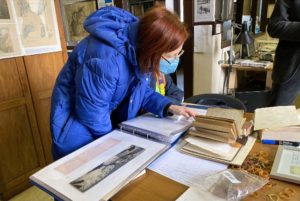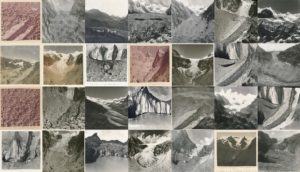In recent months, Cittadellarte has hosted two artistic residencies involving Theresa Schubert and Joshua G. Stein, artists who were selected through an open call curated by UNIDEE Residency Programs within the project S+T+ARTS4Water (2021-2022), part of the S+T+ARTS ecosystem, an initiative of the European Commission promoted within the framework of the research and innovation programme Horizon 2020 to support interdisciplinary collaborations between art, science and technology. The two artists investigated two different regional challenges identified by a team of local experts and researchers, both focusing on water resources and on a sustainable use of water in relation to the Sustainable Development Goals of the UN 2030 Agenda. The two projects went through phases of research, development and production with a view to the final presentation in the context of this year’s edition of Arte al Centro, which will open at Cittadellarte on 1 July 2022.
Rebuilding Relationships with Fluvial Systems: Fluvial systems as indicators of climate change and its impact is the regional challenge Theresa Schubert has been engaged with during these months of research. Theresa develops an artistic practice that intersects art, technology and scientific research, with a particular interest in living organisms. With this project, the artist specifically investigated the presence of glaciers as the origin of river systems, water reserves, ‘memory’ of the Earth’s past and indicators of climate change.

Theresa Shulbert
In the course of the first intensive phase of her residency, the artist met with many experts on the topics of climate change and river systems, and visited places of cultural, scientific and technological interest in Piedmont, Lombardy and Valle d’Aosta. This phase was very important for defining the research area and for gaining an in-depth understanding of the issues related to the regional challenge. During the first week of the residency, two meetings were held with groups of local experts, one in Biella and the other at Turin’s Polytechnic, where Theresa presented her practice and methodology at the crossroads of art, technology and scientific research with living systems. Introducing her research focus on river systems as indicators of climate change, she debated with the experts involved: the researchers discussed their projects relating to high-altitude Alpine areas, data collection models and the simulation and prediction of future scenarios, useful for a process of mitigation and adaptation to climate change. The subject of analysis was also the evolution of watercourses with a study of the relationship between turbulence, sediments and vegetation.
The artist had the opportunity to examine the work of the Italian Glaciologic Committee (Turin), active in Italy since 1895, which coordinates and promotes research in the field of glaciology. In this context, Theresa met with Prof. Marco Giardino, vice-president of CGI, and Dr. Giovanni Mortara, head of the archive. Thanks to these meetings, she was able to view and study a collection of handwritten field diaries dated 1920-1950 by Ardito Desio, one of the most important Italian geologists and glaciologists of the 20th century. His extensive documentation on Alpine glaciers provides valuable data to measure glacier decline and calculate further scenarios. These data and annotations, together with photographs of glaciers from the archives of Fondazione Sella (Biella), have contributed to Theresa’s artistic research by feeding a system of artificial intelligence and machine learning: an algorithm of machine learning models will in fact allow the telling of stories, as it will create landscapes of glaciers that do not and will never exist.

The glaciers
Theresa had also access to the research of several CNR (National Research Council) institutes: CNR-ISAC, where she met with Silvia Terzago and Elisa Palazzi (Turin); CNR-STIIMA, where she met with Alessia Patrucco (Biella); and CNR-IMATI, where she met with Chiara Eva Catalano and Michela Mortara (Genoa). These experts gave her an overview of their current research projects related to water resources and to environmental and ecological monitoring. Elisa Palazzi and Silvia Terzago presented environmental monitoring projects on climate change on a global and local scale in the Piedmontese Alps, with insights into data collection and processing. Alessia Patrucco introduced Theresa to the research projects developed in the Biella laboratory on the topic of regeneration and innovation of textile fibres in the manufacturing sector with a specific focus on sustainability, recycling and respect for the environment. Chiara Eva Catalano and Michela Mortara talked about their projects on water monitoring in the port of Genoa, using sensors and artificial intelligence to implement efficient monitoring, forecasting and planning of interventions. Another important technological input for the development of the project was provided by Fabio Giulio Tonolo, Associate Professor of Geomatics at Turin’s Polytechnic: with his assistance, Theresa explored the use of some of the technologies for satellite monitoring. She also met with Alessandro Spaudo and Emanuele Scopel, co-founders of the startup Silvergeko, which deals with environmental and climate monitoring for applications in agriculture and manufacturing, exploring its sensor technology and data collection.
Theresa visited many places relating to her research on river systems: the Meteorological Observatory at the Santuario di Oropa, the Cordar purification plant in Cossato (Biella), some areas of the river Cervo, the Po River Park in Casale Monferrato, the rice fields in the Vercelli area and the artificial canal system for irrigation.
Furthermore, together with Joshua G. Stein, she presented her research project to the students of the ArtEZ University (Arnhem) in the context of S+T+ARTS Academy and in cooperation with Accademia Unidee. The topics and terms discussed ranged from local changes in climate and biodiversity, already felt in fungal infections, plant invasions, floods and water shortages, to more abstract terms on water as matter, time change, instability, water patterns and turbulence, as well as problems of representation, simulation and effects in the relationship between global and local scales.
Special thanks go to all the people, experts and researchers, who have contributed in various ways to the development of Theresa Schubert’s project: Luca Ridolfi (Full Professor in Hydraulics and Fluid Mechanics, Turin’s Polytechnic); Elisa Palazzi (Associate Professor, Department of Physics, University of Turin); Silvia Terzago (researcher, CNR-ISAC Institute of Atmospheric Sciences and Climate); Marco Giardino (Associate Professor, Department of Earth Sciences, University of Turin; Director, UniTO-NatRisk Research Centre); Giovanni Mortara (CGI office manager); Stefano Perona (CGI member); Valter Maggi (CGI president); Franco Piunti (former Director, Prevention Department, ASL Biella); Chiara Eva Catalano (researcher, CNR-IMATI); Michela Mortara (researcher, CNR-IMATI); Dario Zocco (former Director, Piemontese Po Protected Areas); Fabio Porta (specialist in forestry and the environment); Alessandro Spaudo and Emanuele Scopel (co-founders of the start-up Silvergeko); Andrea Calciati (rice fields expert, Tenuta Margherita, Vercelli); Andrea Pivotto (conservator of the photographic archives, Sella Foundation); Danilo Craveia (archivist, DocBI, historical archives of the Santuario di Oropa, Alta Valle Cervo Documentation Centre); Don Cuffolo (Head of the Meteorological Observatory, Santuario di Oropa); Fabio Giulio Tonolo (Associate Professor, Geomatics, Turin’s Polytechnic; Michele Cerruti But (Lecturer in Urban Planning, Turin’s Polytechnic); Michele Lerro (lawyer, member of the board of directors of CORDAR Biella, former President of Co.S.R.A.B. ); Luca Sala (Director of the Veterinary Animal Health Service, ASL Biella); Paolo Falletti (Natural and Environmental Risks Department, Arpa Piemonte), Francesca Vietti, Chiara Cisaro, Paola Guala (North East Department, Arpa Piemonte); Annalisa Zegna (artist, project Osservatorio sul Torrente and Spazio HYDRO); aaron inker (artist, project Osservatorio sul Torrente and Spazio HYDRO); Nicolò Polidori (expert in agrarian chemistry and gold prospector); Claudio Tonin (former Research Executive, CNR-STIIMA); Diego Presa (former Vice Mayor and Environmental Councillor for the Municipality of Biella and former President of ATO2 Vercelli, Biella, Casale and Valenza); Maurizio Di Lella (technician expert in hydraulic systems and OO.PP. for the territory of the Province of Biella, Regione Piemonte); Andrea Polidori (agronomist, owner of the Agronomy and Landscape Architecture Studio and President of the order of agronomists and foresters of the province of Biella and Vercelli).
The following institutions are acknowledged for their contribution in facilitating the exchanges and in supporting the research: ARPA Piemonte, Cordar S.p.a. Biella Servizi, CGI Italian Glaciologic Committee in Turin, EuroCold Lab at the University of Milan Bicocca, Turin’s Polytechnic, University of Turin, Fondazione Sella photographic archives, CNR-ISAC, CNR-IMATI (Institute of Applied Mathematics and Information Technology), CNR-STIIMA (Institute of Intelligent Industrial Systems and Technologies for Advanced Manufacturing), DocBI Biellese Studies Centre, Meteorological Observatory at the Santuario di Oropa.
* S+T+ARTS is an initiative of the European Commission as part of the research and innovation programme Horizon 2020 aiming at facilitating collaborations between science, technology and art to implement a European approach to technological innovation focused on human needs and values. The EU-funded S+T+ARTS ecosystem aims at expanding its network by bringing together artists, engineers, researchers and supporting institutions to promote hybrid collaborations.
The S+T+ARTS4Water consortium is led by LUCA School of Arts (Belgium) and includes Thyssen-Bornemisza Art Contemporary – TBA21 (Austria), Universal Research Institute (Croatia), V2_Lab for the Unstable Media (Netherlands), Ohi Pezoume / UrbanDig Project (Greece) and Cittadellarte – Fondazione Pistoletto (Italy), with the collaboration of partners STARTS Gluon (Belgium) and BOZAR (Belgium).

